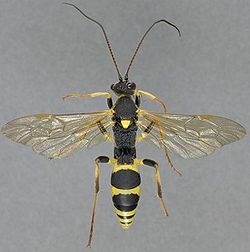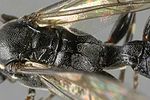Ichneumon wasp
| Ichneumon wasp |
|---|

|
| Scientific Classification |
|
| Families and Subfamilies |
|
Family: Braconidae
Family: Ichneumonidae
|
| This image shows a rhyssa persuasoria. One of the one hundred thousand species in the superfamily Ichneumonidae. |
The Ichneumon wasp are any of the species of wasps that belong to the taxonomic Superfamily Ichneumonidae. It is a long, slender, and parasitic wasp that has a long ovipositor used to distribute venom and eggs for reproduction. It has common organs for a wasp. Its wings, however, are small compared to the large body and can only carry the animal for a short distance. Although it is parasitic it can eat other things like honeydew. This particular family is very large with species on almost each continent. There are over three thousand species in America and they are very common. These parasitic wasps are useful to keep the other insects population from getting to large. The Ichneumon wasp is one of God's creatures and is essential to a certain part of the ecosystem.
Anatomy
The Ichneumon wasps body has a common insect anatomy. They have a specific coloring to each species. The physical look of the insect looks like a mix of the dragonfly and a wasp. The antenna has fewer segments then a normal insect.[2] The digestive system of the Ichneumonidae involves a pharynx, an esophagus, a crop, a proventriculus, a ilieum, a colon, and a rectum.[3] Ichneumon wasps have a stinger or an ovipositor as it can be used for both, sometimes even at the same time. However this egg laying appendage or defensive weapon can is exclusive to the female ichneumon wasp and can be longer then the female's body. These traits and mating behavior can vary between the genera, such as Ryhssa and the Megarhyssa.[4] Some scientists believe that the female can drill through the wood to the host, horntail wasp, with the ovipositor because it is sharp. Others say that it is because in the female there are small traces of metal in the tip of the ovipositer[5]. As for the young ones emerging from the wood, some scientists say that both genders have small traces of metal not only in the ovipositor, but also in the antenna and the teeth.
Reproduction
The Ichneumon wasp superfamily uses their unusual tails or stingers to deposit their eggs [6]which are accompanied by some venom. The Ovipositor cannot simply just lay eggs and it cannot simply just use venom, except when threatened into a defensive state.
Most of the females in the super family deposit their eggs into larvae but animals and their fur work just as well, as they are parasitic. Then the male wasp's, sometimes ten at a time [7],will come and fertilize the eggs. The eggs will develop for a couple of days and feed on their host internally or externally.[8] The parasitic larvae of the Ichneumon wasp are known commonly to kill their host.
They will hide in the animal or on the outside of the animal in the fur and slowly suck the nutrients from the host and grow. The larvae are dependent on the host for the first couple weeks. They are born without legs or wings and are helpless if they are separated from the host. If they are injected into horntail wasp larvae, into the tree bark where the larvae is located, they will emerge from the tree as nymphs. The baby wasp is now on its way to its new life. The average adult Ichneumon wasp can live for at least 27 days[9]
Ecology

The ichneumon wasp, or Ichneumonidae class, eats a variety of things. Although they are mostly parasitic some of them eat other things. There are a few species that sometimes eat honeydew or wild flowers when no other food is available[10]. These insects mostly live in the cool moist climates but many can live in warm dry climates[11]
Although they seem dangerous with their stingers they kill mostly harmful insects that would ruin crops or be hazardous to humans or essential wild animals or livestock. Their affect on their environment resembles that of a spider, they seem hazardous or dangerous but mostly their help outweighs their harm.With the Ichneumon wasp being so hard to identify specifically scientists still have a lot to learn from these creatures.
Ichneumonidae Family
For an insect family this is about as diverse as they come. The Superfamily Ichneumonidae has about one hundred thousand members and all vary in only about a couple of ways to the previous one. They all have the basic anatomy but the real differences are in the behavior, or the use of the anatomy, and the area they are indigenous to. They are located on several different continents like Asia, Europe, Australia, and over 3000 species are located in America alone. Because their size is so great they are a worst nightmare for scientists who try to identify their species. Many people think that the Ichneumon wasps are an exotic or dangerous the first time they see one. However the Ichneumon wasps will not harm anyone unless harmed themselves, like most of nature.
Gallery
References
- Essortment.com none, Essortment.com,accessed Dec 9th 2010.
- jstor.orgHarold Heatwole and Donald M. Davis, jstor.com,1965.
- Missouri Department of conservation.com Connie Hjelmeng-Johnson,MDC.com, May. 2, 2002.
- tititudorancea.com wikepedia, ,tititudorancea.com, Oct 11 2010
- science direct.comnone, science direct,accessed Dec 9th 2010
- hedgerowmobile.comnone, Hedgerowmobile.com,accessed Dec 9th 2010
- esajournals.orgHeatwole, Harold, and Donald M. Davis, jstor.com,accessed Dec 9th 2010







